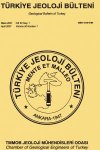
-
2025
-
2024
-
2023
-
2022
-
2021
-
2020
-
2019
-
2018
-
2017
-
2016
-
2015
-
2014
-
2013
-
2012
-
2011
-
2010
-
2009
-
2008
- 2007
-
2006
-
2005
-
2004
-
2003
-
2002
-
2001
-
2000
-
1999
-
1998
-
1997
-
1996
-
1995
-
1994
-
1993
-
1992
-
1991
-
1990
-
1989
-
1988
-
1987
-
1986
-
1985
-
1984
-
1983
-
1982
-
1981
-
1980
-
1979
-
1978
-
1977
-
1976
-
1975
-
1974
-
1973
-
1972
-
1971
-
1970
-
1969
-
1968
-
1966
-
1964
-
1963
-
1961
-
1959
-
1958
-
1955
-
1954
-
1953
-
1952
-
1951
-
1950
-
1949
-
1948
-
1947
Abstract: The Çamlıca metamorphic association located on the western part of the Biga Peninsula covers an area of2about 196 km . The rock units of the Çamlıca metamorphic association are separated in three units, which aredescribed as formations based on the partly determined internal structure, on contact relationships, and on amappable unit. These formations from bottom to top are, respectively: the Andıktaşı formation which comprisesmetalava, metatuff, and metapelite and that appears brown, green, and yellowish green-coloured in the field; theDedetepe formation which is mainly made up of quartz-muscovite schist, garnet-muscovite schist, garnet-albitechlorite schist and albite-chlorite-epidote schist, black marble, calc-schist, amphibolite and eclogite. On the top,the Salihler formation is composed mainly of phyllite, calc schist and white marble intercalations. The Denizgören ophiolite, including serpentinised peridotite, tectonically overlies the Çamlıca metamorphic association. Petrographical investigations, using index minerals of albite - garnet - epidote - chlorite observed in threedifferent formations, indicate that the Çamlıca metamorphic association was subjected to the greenschist - faciesmetamorphism. An early eclogite - facies mineral assemblage of garnet + omphacite + glaucophane + amphibolehas been determined. These mineral associations were subjected to amphibolite-facies metamorphism and finallyto retrograded greenschist-facies metamorphism. The Çamlıca metamorphic association is, then, probably anequivalent of the Iznik metamorphics located in the Sakarya Zone in terms of lithostratigraphy, stratigraphy andmetamorphic characteristics.
Abstract: In thisstudy, volcanic rocks outcropped in theKefken-Kerpe (north ofKandira) areawere investigated interms of their geochemical and geological characteristics. The field studies undertaken around Babakoy, Kefkenand Cebeci indicated that Çangaza volcanic rocks and the Late Cretaceous-Early Eocene Akveren formation alsocontaining Sermi limestone are the main lithological units in the area. The Early-Middle Eocene Caycumaformation, composed mainly of a sandstone, siltstone and claystone sequence, overlies uncomformably the olderunits. Petrographical and petrological analyses of Cangaza volcanic rocks show that these rocks are mainlycomposed of andesitic and basaltic-andesitic rock types. Major oxide geochemical analyses of 22 samplesindicated that the rocks are subalkaline in character. Trace element characteristics of the volcanic rocks areconsistent with an origin formed by a calk-alkaline Island Arc Tholeitic (IAT) magma within an oceanicsubduction system.
Abstract: in this study, the sedimentological characteristics of lower Miocene (Burdigalian) aged Adilcevazlimestone that outcrops north of lake Van were determined by means offacies analysis. Using these data, anapproach to establish the Lower Miocene paleogeography of the study area was made.After field studies, laboratory studies were undertaken and the limestone was separated in 6 microfacieses. These are1. Wackestone-packstonefacies with redalgae andcoarse bentonic foraminifera2. Boundstone facies with red algae and Bryozoa3. Boundstone facies with red algae and coral4. Calciruditefacies with redalgae andcoarse bentonic foraminifera5. Wackestone-packstonefacieswith Globigerinoidae6. JVackestonefacies with red algae and Lepidocyclina sp. These facieses were used in an approach to the paleogeographical evolution of Adilcevaz limestone. Observations infieldstudies andfindings infacies analysis indicate that theAdilcevaz limestone was deposited ina carbonate shelf which bears abundant red algae.
Abstract: Recent developments in computer programs and information technology have resulted in an increasinginterest in the use of DEMs in tectonic studies. Geographic Information Systems (GIS) and Digital ElevationModels(DEM) have been extensively used in morphological and tectonic studies and give good results, especiallyin revealing the morpho-tectonic features of a geologically unknown region. The study reported here comprisesthe extraction and analysis of landforms using the geographic information system analysis of a region where strikeslip faulting has a dominant role in the formation of landforms. The morpho-tectonic characteristics of the area,which stretchesfrom a point East of Gerede to İsmetpaşa on the NorthAnatolian Fault Zone (NAFZ), were studiedusing GIS and digital mapping techniques. Landsat ETM+ and shaded relief images were also used in order toperform lineament analysis.Typical landforms associated with a strike slip faulting regime, like offsetstreams,sagponds etc. were recognized by DEM and the results were supported with field observations. The advantages anddrawbacks ofthe use of GIS in tectonomorphologic studies are discussed asthe result ofthis work.

 TMMOB
TMMOB